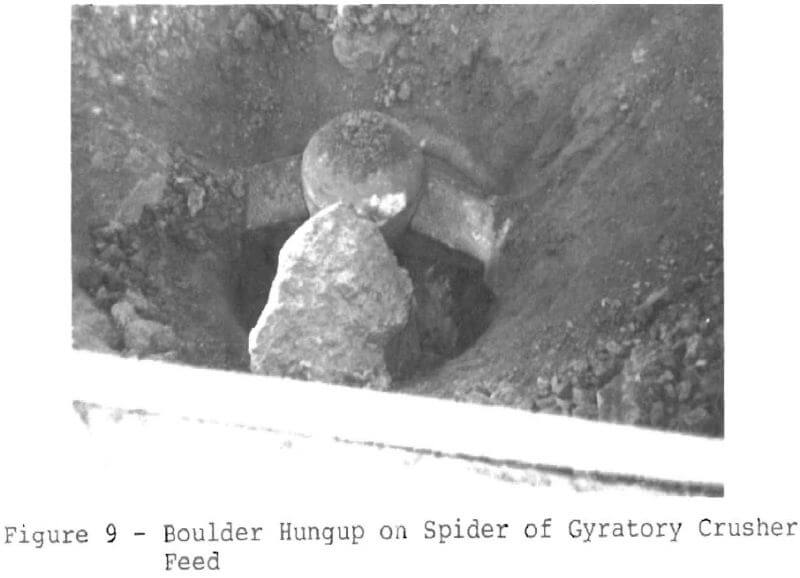Table of Contents
In mining and quarryinq, the mineral commodity as present in the ground may be composed of rock blocks that must be reduced in size, to suit market requirements. The rock in place will be blasted, loosened, and then hauled away to the first processing step-size reduction. As delivered from the blasting area the rocks will range in size from dust to blocks several feet on a side. The crusher employed for the initial size reduction will have a maximum size rock capacity, and when any oversized rock is delivered, it lodges in the crusher and the materials flow in the mine or quarry is halted.
Whenever rock passes through openings, there exists a possibility for blockage by oversize pieces. This is particularly true when dealing with rock undergoing blasting primary breakage or collapse and drawing in a caving mine. Crusher and grizzly openings are the first size restriction for the materials handling process and therefore may plug by bridging or by oversized material. When this happens, several courses of action can be taken, depending on the hangup accessibility.
Manual techniques like sledge hammers or pry bars may be used to break or loosen boulders, but take excessive manpower and time. Hydraulic and pneumatic impact breakers are available but they are expensive. Blasting is often viewed as the most economical and quickest method for boulder breaking, and also requires very little effort from personnel. However, the person doing the blasting may not be experienced with explosive use. Since a blast in a crusher can be carried out at any random time, the blast area may be difficult to keep clear of personnel and equipment. Equipment near the crusher or grizzly could be damaged from blasting. Although blasting is the quickest method it is also potentially the most dangerous and destructive method. With improved practices and technology in this area, it is hoped that accidents resulting form boulder blasting can be reduced.
The Bureau of Mines recognizes the hazards involved and initiated this project to examine present practices, regulations, and safety records so as to recommend safer procedures and present improved technology for boulder blasting in crushers. In addition, all available literature dealing with boulder handling practices was examined.
Field visits were conducted to meet with operators firsthand about problems in handling boulders and the development of their chosen procedures. These visits were nationwide and covered many different types of rock, mining methods, and boulder handling equipment.
Rock Crushers
Crushers are generally very large machines that subject rocks to compressive forces that cause rock failure and thereby size reduction. The various components of a crusher system will be described below as well as the problems of boulder handling in each.
Delivery Systems
There probably are as many kinds and types of material delivery systems as there are applications for them. The delivery systems generally are pan type feeders or vibrating grizzlies that transport the rock from the hopper to the crusher mouth. Pan feeders are basically steel segmented conveyor belts, while grizzlies, whether vibrating or stationary, are a set of parallel bars set apart from each other a distance which permits passage of only the maximum size rock that can be easily handled in the next stage of rock processing. Grizzlies are usually built heavier than necessary in order to withstand secondary blasting either above or below the grizzly level. Vibrating grizzlies utilize the motion to feed a crusher with properly sized rocks while allowing undersized material to bypass the crusher, decreasing required crusher capacity. Figure 1 shows a hopper and vibrating grizzly arrangement. Grizzlies can also be installed stationary as equally spaced parallel bars sloping from the dump to the crusher mouth as shown in Figure 2. Storage hoppers are not needed since oversize rock falls down the incline immediately after dumping. Oversized rock can bridge or hang-up in these feed systems as in Figure 3. The advantage in such a system is in dealing with a disruption in rock flow and hang-up before the crusher mouth with easier access to the problem area.
Rock Crusher Types
Rock can be broken by compression, impact, and attrition in the various types of crushers developed for mining. Crushers are selected on the basis of the material being crusherd, such as physical structure, geological classification, hardness, and the chemical constituents.
Blockage occurs when a rock, because of size or shape, bridges across the crusher feed opening so that the crusher forces cannot be applied. This blockage can also prevent
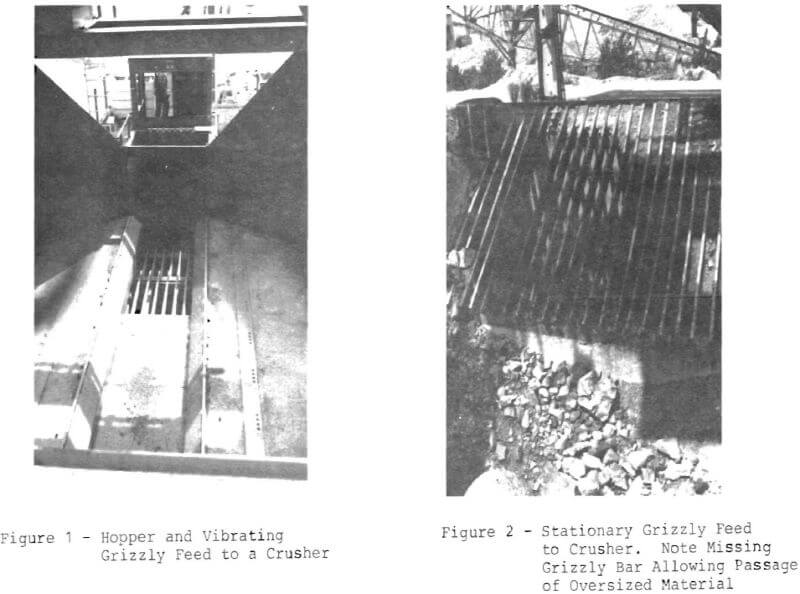
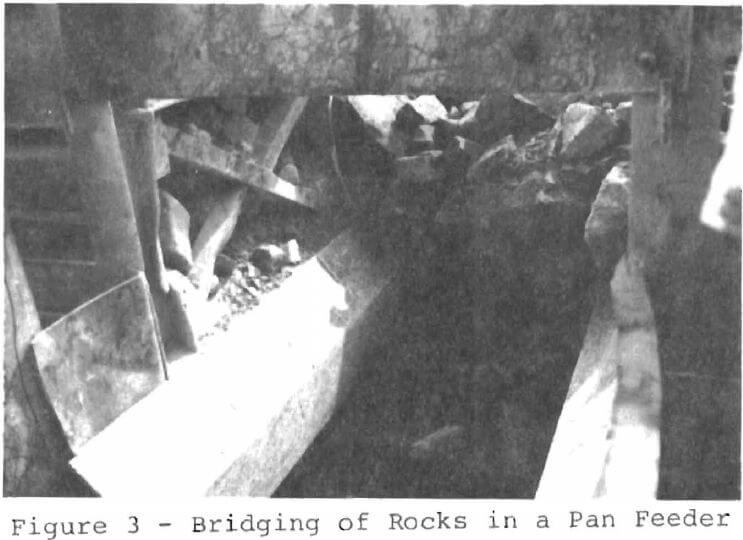
empty. This is a beneficial condition for blasting in that the existing air space acts as a cushion and therefore reduces excessive shock transfer to the crusher. This can offer some solace to the operator, but several crusher manufacturers contacted recommend blasting only as a last resort.
Gyratory Crushers
Gyratory crushers, shown in Figures 4 and 5, have a conical head with an eccentric movement inside an outer concave bowl. They are designed for high capacities. A straight vertical discharge prevents the packing of sticky materials (Pit and Quarry, 1977). Boulder blockage will occur if rock bridges the crusher perimeter and the spider supports that span the intake diameter. Obviously, any blasting can affect these supports and throw the cone out of alignment. The majority of the operating mechanisms are underneath and to the bottom side of the cone. Hence this area is susceptible to shock forces from boulder blasting which could cause cracking of the outer shell or loosening of the drive shaft.
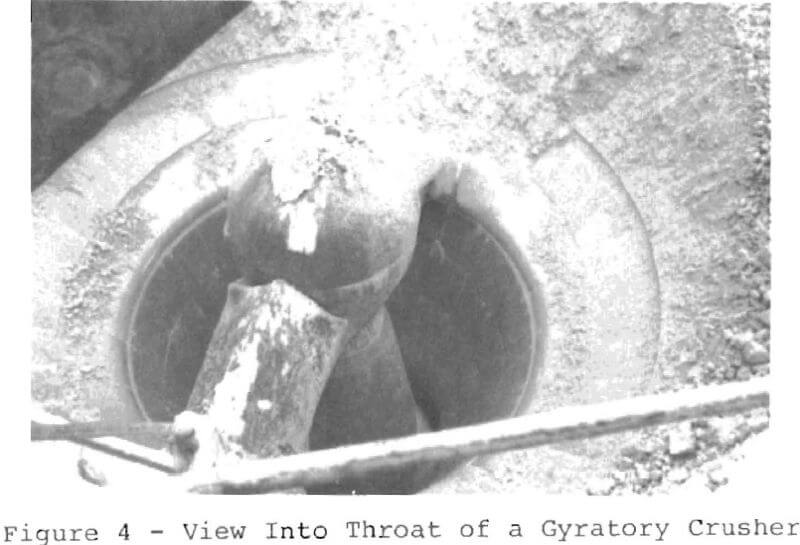
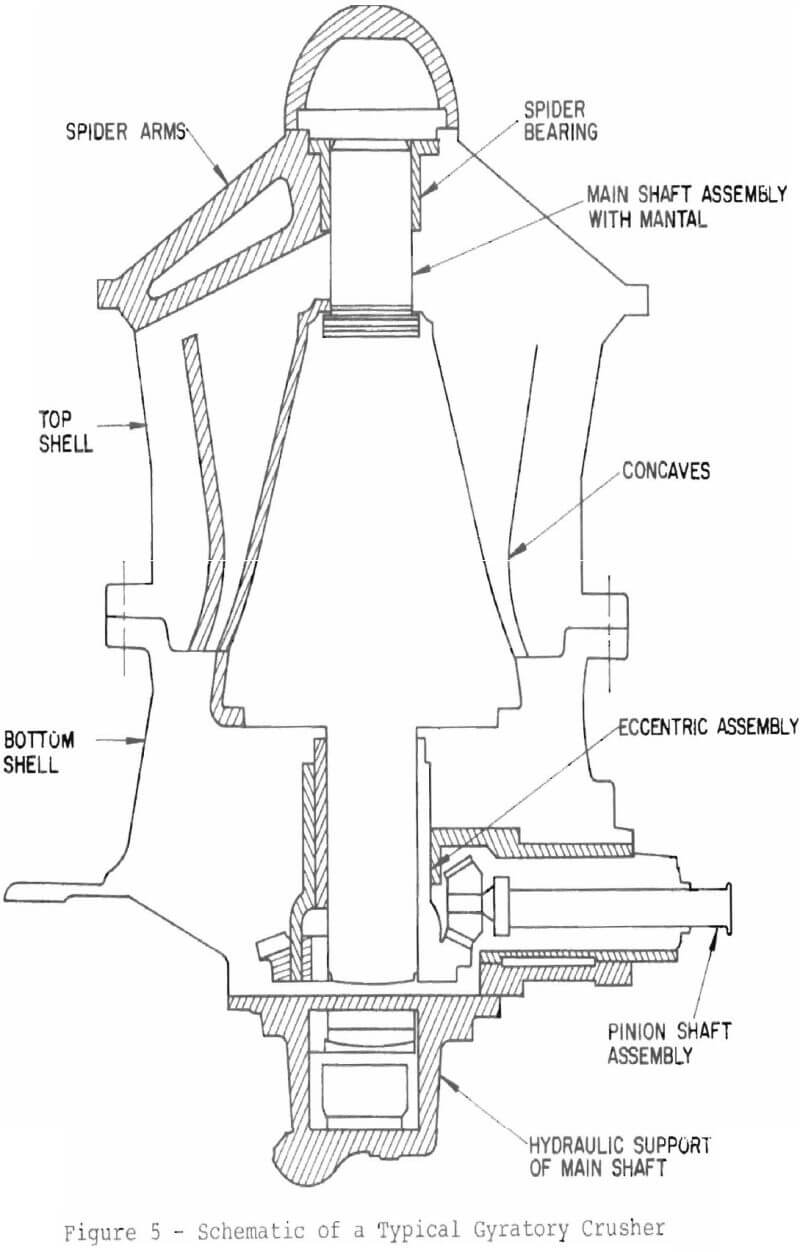
Jaw Crushers
Jaw crushers, shown in Figure 6, are the oldest type of crusher in use. They are economical when dealing with a coarse or blocky feed although capacities are low. The swing jaw, powered by an eccentric, moves downward and toward the stationary jaw to crush, then moves up and back to allow crushed material to exit. Slabby rocks tend to slide down the crushing chamber untouched until their width equals the discharge dimension. Jaws can be concave to encourage rock falling lower in the crushing chamber, preventing packing (Pit and Quarry, 1977).
A boulder could bridge the opening, or be at an odd position relative to the moving jaw, so that crushing action does not take place.
The eccentric wheel mechanism location prevents easy access to a boulder. It also is most vulnerable to blasting effects. The swing jaw and main frame, as well as toggle bolts and bearings, are also susceptible to blasting damage.
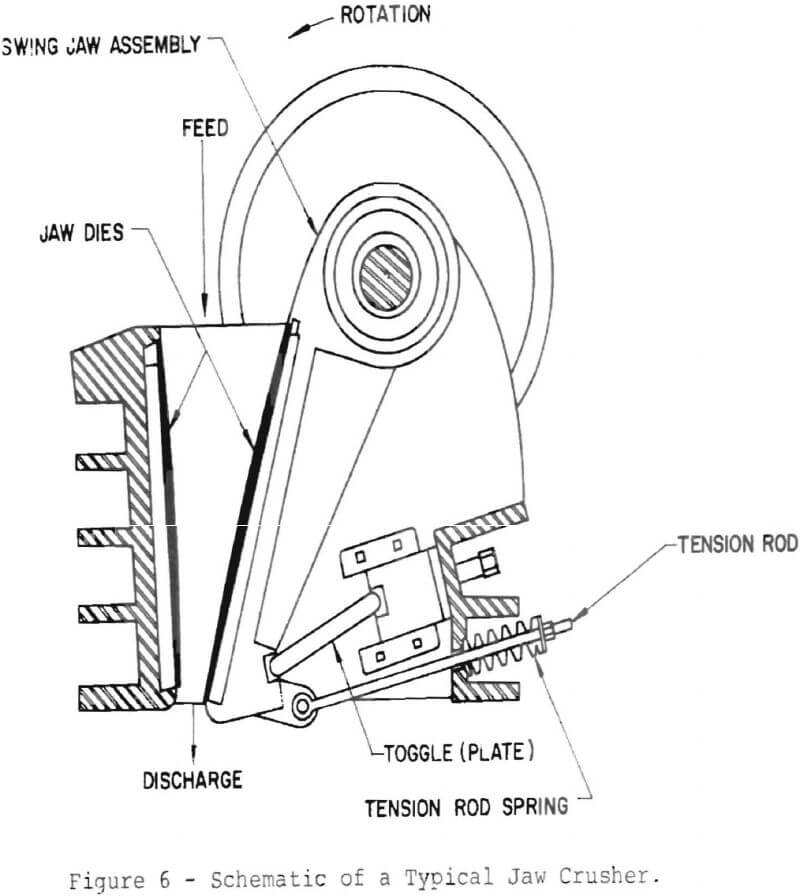
Roll Crushers
Single roll crushers, shown in Figure 7, use shearing action to break soft rock. The main part is a knobbed roll where the knobs extend 3 to 4 inches beyond the roll surface. Rock is caught between the roll and the stationary breaking
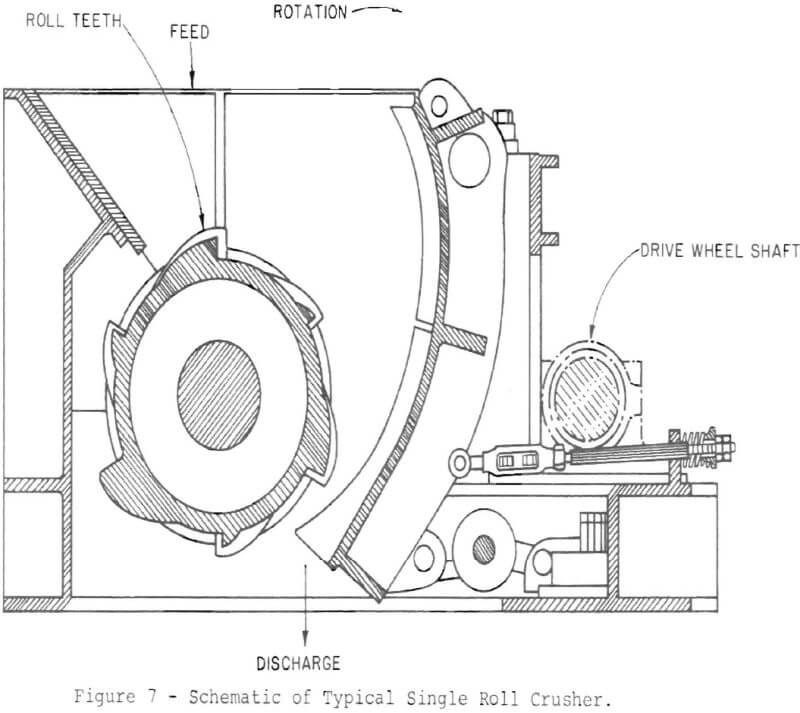
plate where it is continually hit and pushed by the roll knobs. The breaking plate, hinged at the top with the lower edge set on springs, can back off if an uncrushable material enters (Pit and Quarry, 1977). Large boulders can easily bridge themselves over the roll and avoid contact. The crusher knobs must be kept sharp so that a boulder does not bounce off the knobs and avoid crushing. Roll crusher drive wheels and roll shafts are extremely vulnerable to blasting damage.
Hammermills
A typical single roll hammermill or impactor is shown in Figure 8. In the hammermill the feed drops free and is hit by the crushing surface traveling at high speed. The rock shatters on impact and pieces are thrown toward a breaker plate for further size reduction. Blockage can occur whenever a boulder does not fall far enough into the feed opening to be exposed to the crusher hammers; consequently, no work can be performed on the rock. In many cases, the crusher design offers a means of access to alter the boulder position or enable other remedies to be tried (Pit and Quarry, 1977). Boulder blasting in this type of crusher can cause damage to the impactor shaft or bearings.
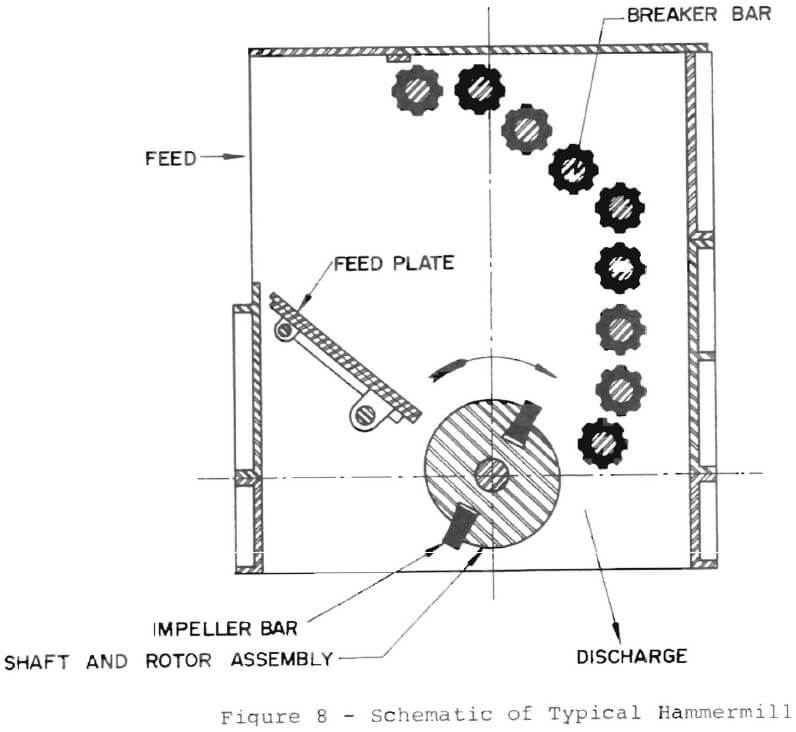
Rock Boulders
A boulder, in common mining usage, is any rock larger than the desired size. What is desirable in a riprap operation may be a problem in another operation.
Sources
Boulders originate in a mining operation during the primary blasting of the commodity mined. This blasting must adhere to accepted design and execution to result in good rock fragmentation. Long stemming or poor hole spacing, for example, contribute to the creation of boulders. Geology also enters in that hard lenses may occur and be difficult to break or easily dislodged from the bench. Joints, bedding planes, and clay seams in the rock are also factors that determine blasting fragmentation, and some mineral deposits may tend toward slabbiness or blockiness. As previously discussed, primary crushers are selected chiefly on the basis of the incoming material characteristics.
Delivery
Most boulders are set aside from the loading area and are blasted later. Sometimes a boulder may be truck loaded inadvertently if hidden in the muckpile. Loading operator experience and close supervision can prevent this from happening too often. It is important, for safety reasons, that boulder blasting be done in the pit. Loading equipment should have a proper bucket size matched with the crusher feed in order to help eliminate the transportation of oversize rock to the crusher.
Material handling equipment in a mining operation must be carefully matched for peak efficiency. For example, large capacity loading equipment would not be practical if the crusher mouth could not receive the larger loaded rocks. Oftentimes this mismatch occurs at smaller mining operations where equipment may be secondhand and purchased at a lower price rather than to meet specific requirements. The occurrence of boulders is further compounded in that small operators usually give inadequate attention to blast design, and cannot afford to hire a knowledgeable blasting foreman. The operator may not know how often boulders get hung up in the crusher, or how much time is lost to remedy that condition; it is just an accepted part of the operation.
Blockage of the crusher feed can be caused either by bridging of material or by a boulder too big for the feed opening. If material is wet and sticky, several smaller rocks can bridge over the feed opening and avoid crushing.
This usually happens when the delivery system is stopped and rock can settle and key together forming a bridge. Once the feed system activates, the material under the bridge is drawn out. The problem is more prevalent in cold weather where ice can freeze rock together.
Another form of crusher feed blockage results from a large boulder that cannot enter the feed, as shown in Figure 9. Occasionally the boulder can be repositioned in the feed system so that a smaller dimension of the boulder can be nipped by the crusher mechanism. If the feed system does not have this flexibility, then the boulder must be moved by auxiliary means which will be discussed at length in later sections.
